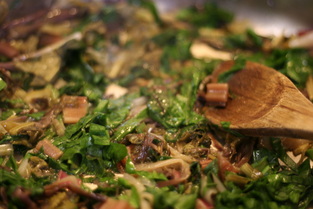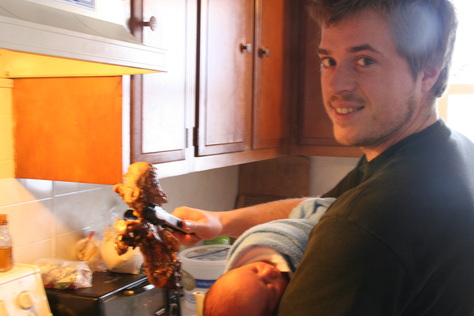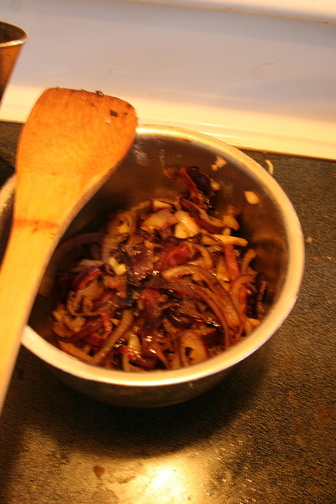 Freshly washed ramps await further processing Ramps are a seasonal wild delicacy found in forests from the Carolinas to Canada in early spring. Popping up in clumps in the cold damp of April, they thrive like any plant in the leek/onion family this time of year. Preceding the warm months but offering some fresh veggie relief after a long winter, ramps are a wonderful harvest and only take a little digging and washing to enjoy. Below I de-mystify these roots that even two months ago, I had never heard of! And we've got them, by the way, if you want to step outside the onion box! Ramps can be used just like green onions. Simply peel the outer layer off and cut the bottom of the bulb off with the roots. You will be left with a 3 to 5 inch piece ready to use.  Ramps, because of their complex onion and garlic flavor are a great addition to almost any dish. Thin slice and use raw in salads or as a garnish. Slice "on the bias" (turn the ramp 45 degrees and cut thin, oblong slices) and add to dishes for an asian flair. The greens can be used fresh on sandwiches or in salads as well as being sautéed or added to egg dishes. Here are some great ways to use ramps as a focal point in a meal. "First of the Season" Soup, with Wild Ramps This is a great soup that celebrates all of the early greens that are coming out at early markets or at the Co-ops. It also uses some leftovers from the root cellar. 4 large potatoes (peeled) 1 lb Wild Ramps (stem sliced into medallions, greens julienned cross the leaf in 1-2" strips) 1/2 lb Fresh Sorrel (julienned like ramp greens) 1/2 lb Swiss Chard (Julienned) or Spinach (left whole) 1 cup high quality chicken or vegetable stock (use veggie if doing optional "fish soup") 1 cup cheap white wine 1 cup whole milk 1 cup Heavy Cream 1 clove garlic 1 tbsp chopped fresh (if available) tarragon 1 tbsp kosher salt 1 lb of your favorite local fish (frozen is fine, but thaw it for the soup) (optional) Cut the potatoes into chunks and boil until tender. Drain and coarsely mash. Add all ingredients but milk, cream, sorrel and spinach (if you're using it) and cook for about 10 minutes. Add remaining ingredients and cook for 2 more minutes. Serve with hearty bread. Rustic Ramp Pesto Leaves from 1 lb Wild Ramps (for a bolder flavor, retain the stems) 2/3 cup roasted nut (pine nuts are traditional, but I like using walnuts or pecans) 1/3 cup Extra Virgin Olive Oil 1 tsp kosher salt 1/2 tsp sugar 1/2 cup (up to a full cup) shredded or sliced parmesan, coarsely chopped Chop or crush nuts until finely coarse (does that make sense? You want them very small but uneven). Pulse ramps, olive oil, sugar and salt in a food processor until mostly smooth (you want a bit of texture, looking a bit like green stone-ground mustard). Pour into a mixing bowl and fold in nuts and 1/2 cup parmesan. Add more parmesan if you need it a bit thicker. Some great uses for this tasty treat is on crackers or dry bread, mixed into pasta or even on pizza! You can also mix it into scrambled eggs for a unique and flavor dish.
7 Comments
Makes 8-10 medium sized sandwiches
Prep Time: 25 minutes Cook Time: 2.5 hours (1) 2 lb Organically Raised SBM Ham Steak 10 Dinner Roll sized Buns 6 Large Yellow Onions, Sliced (halved and slices in thin strips) 10 Slices Cheese (Swiss, Gorgonzola or Brie are great options) 2 cups apple or orange juice 1 Tbsp Salt Roasted Mustard Aioli 1/4 cup Yellow Mustard Seed 1/4 cup Brown Mustard Seed 1 Tbsp Mustard Powder 1 Tbsp Sugar 1 Tsp Kosher Salt 1 cups Real Mayo Preheat oven to 275 degrees. Salt Steak and add high temperature oil to pan. Brown on Med-High heat until steak has nice golden coloring. Place in sealable pan and add juice. Cover and put in the oven, turning the steak every 1/2 hour. Add more oil if necessary. Add all the onions to the hot pan and sprinkle on 1 Tbsp Salt. Scrape pan and slowly brown onions. Keep the heat around Medium being sure that you are not charring the onions. You want a nice slow "sweat" (check the "recipe" section on the website for more on this technique) so that the onions release their sugars and caramelize. This should take about 10 to 15 minutes. When finished they should be reduced by over half and kinda thick and gloopy. Roasted Mustard Aioli In a large pan roast mustard seed over medium heat. Stay moving the pan and scraping for entire time (DO NOT LEAVE IT). Seeds will start to pop and have a lovely roasted smell. Seeds are finished when they are slightly darker and not popping as much. Allow to cool in mixing bowl and add remaining ingredients. Mix to incorporate. When meat is finished and is crumbling when pressed with a fork, take it out and shred the meat. Spread Aioli on Buns and top with ham and caramelized onions. Add cheese to top and place in 400 degree oven until cheese is melted. Sautéing is one of the most primary tools in a chef's arsenal. For that reason there are many misconceptions about what it is and what it is not. It is: A way to heat food to a point where it begins to excrete juices and thus heat and caramelize the sugars. It is not: A way to "seal in the juices" on a steak or roast. It does quite the opposite; as the food cooks, flesh breaks and cracks and actually allows the meat to release more liquid. It is: A technique that, when used in tandem with other methods can produce exquisitely rich foods. It is not: Simply relegated to chicken breasts, hamburgers and onions. Building on our lesson "On Cooking", sautéing makes principle use of heat and moisture control. High Heat - Searing Searing is used when you want to brown the outside of something. The "brown" is actually fond. These are the juices of the item that are being released quickly from the food. With the juices are all sorts of compounds like fats and sugars and vitamins. These become super concentrated in the high heat of the pan and bind themselves to the item being cooked. In addition, the food itself is cooking rapidly which produces some really delicious flavors and does some great things texturally. *sidenote* I'm sure you've heard this but it really is genuinely dangerous to cook on Teflon cookware. Virtually all of the world has outlawed Teflon and the U.S. will follow suit by 2015. Teflon has been proven to cause cancer. In order to properly sear you need to use an oil that can take a pretty high heat (this is not EV Olive Oil, this should only be used for low heat cooking. Rule of thumb, if your EVOO is producing smoke, it's giving you cancer) like canola or (ideally) organic coconut oil. With your pan on high, add your oil (enough just to coat the bottom of the pan) and give it a few seconds to come up "to temp". Salt whatever you are about to sauté liberally. The salt will help draw out more liquid ("lysing") and thus more flavor. Depending on what you are cooking it is vital that you do NOT move it too much. You are simply trying to produce that outer crust. If the pan is not hot enough or you are constantly flipping it over and over, you will not maintain the high heat that is necessary for searing. If you are searing a steak or a roast, it should stay untouched for about 2 minutes per side (if it is a big roast like a rolled rump or sirloin tip, think of it like a cube being sure to take the time to sear every side). You will know that it is done when it releases easily from the pan (the food will form a bond with the pan and once a certain temperature is achieved, the bond breaks. Try and pull the food before then and half your steak will stay firmly stuck to the pan). If you are searing veggies, lay out a thin layer of whatever you are cooking. It is important that as much of them touch the pan as possible. If any are sitting atop one another then they are steaming and that is a different process (covered later). Scrape the pan with a wooden spatula until the veggies are a uniformed brown. What to do with it...
At this point you have several options. Your steak is ready to eat or broil, your roast is ready to be braised in the oven (don't forget to deglaze and loosen up all those tasty bits at the bottom) and your asparagus is ready to plate. Sautéing is a great way to offer up some very hearty flavors into dishes that seem to lack depth. Adding sautéd onions to just about anything with up the savory factor by like a billion (give or take). Low Heat - Sweating Sweating is used for a few different reasons. Principally for caramelizing (onions) but also for softening or producing pan juices. Regardless of the reason for sweating, the focus is controlling the moisture. You want to release as much of it as possible and in the case of caramelization you then reduce that liquid to break down and gently brown the sugars (caramel). When cooking with a low heat a chefs options for oil increase. Now you get to use the really tasty stuff: butter, EVOO and a few unrefined (read, "flavorful") oils. Also, it is important to salt liberally. You want to pull out as much moisture as possible and the salt will help with that. The trick to sweating is really just to let the food rest in a slow quiet sizzle. You want to avoid browning and promote caramelizing. This can take in upwards of 20 minutes depending on how full the pan is. During this process it is ok to "crowd the pan". The heat from the bottom will help steam and soften the stuff near the top so when you stir it, the juices get released and worked into the dish. What to do with it... At this point those dark brown gooey caramelized onions are ready for that burger you just seared, the carrots can be drizzled with maple syrup for a sinful side and the cauliflower can be blended for starch-free mashed "potatoes". Sautéing is a real joy to master. Learning the unique flavors that are produced depending on the thing being cooked and the temperature of the cooking is both exciting and rewarding. Soon you'll be searing and sweating and sautéing all sorts of shnazzy things all in one pan to the joy and jealousy of all your friends. And remember: Love to cook - cook to love. |
Archives
March 2012
Categories
All
|






 RSS Feed
RSS Feed